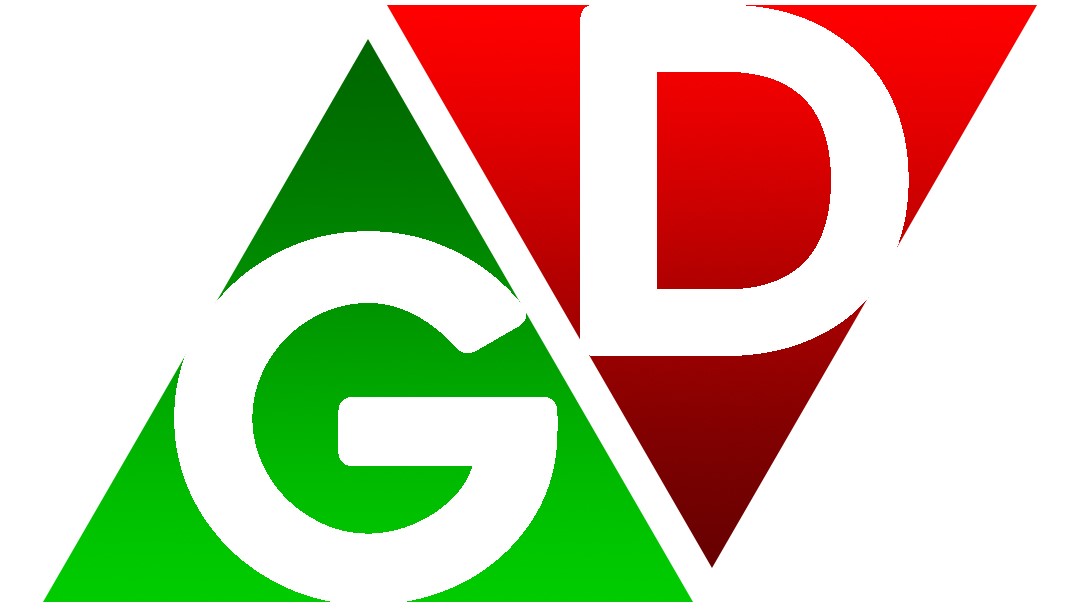There is hardly any other effect that can completely transform a track like reverb. Thanks to this magical effect, a dry vocal can sound like it was recorded in a cathedral, or a snare drum can give the impression that it is located in a huge hall. As there are so many reverb plugins available, choosing the right one can be overwhelming, but the good thing is that each plugin has its own character and purpose. It doesn’t matter if you’re looking for a lush atmosphere, subtle depth, or experimental sound design, there’s a plugin out there for you.
Cast your vote for the best reverb plugins:
1. Lexicon MPX Native
7 classic Lexicon reverbs: Small Plate, Large Plate, Small Hall, Large Hall, Small Chamber, Large Chamber, and Room.
100+ professionally crafted studio presets, including exclusive artist presets.
Graphical real-time visualization illustrates full spectral intensity.
Vivid input and output metering offers an at-a-glance assessment of your audio levels.
2. Relab Development LX480
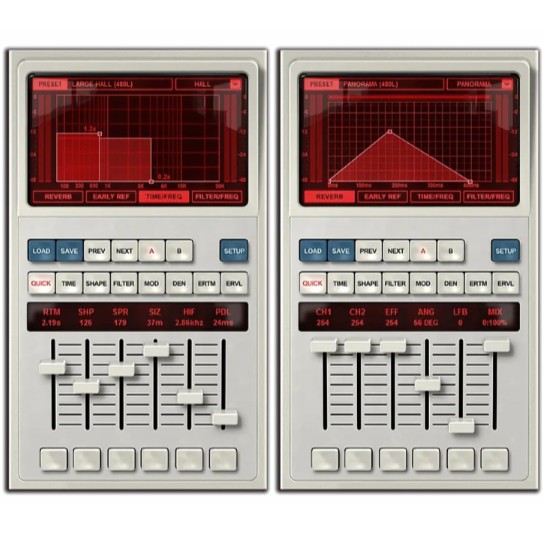
Included algorithms: Random Hall, Hall, Plate/Room, Random Ambience, Twin Delays.
Upgraded with higher-density algorithms, quick controls, and a customizable display.
Surpasses the original hardware with continuous controls, flexible filters for improved sound shaping, more ER delay lines, stereo manipulation, and 88.2KHz and 96KHz support.
Dual-engine configurations produce ultra-wide reverbs.
3. Strymon Big Sky
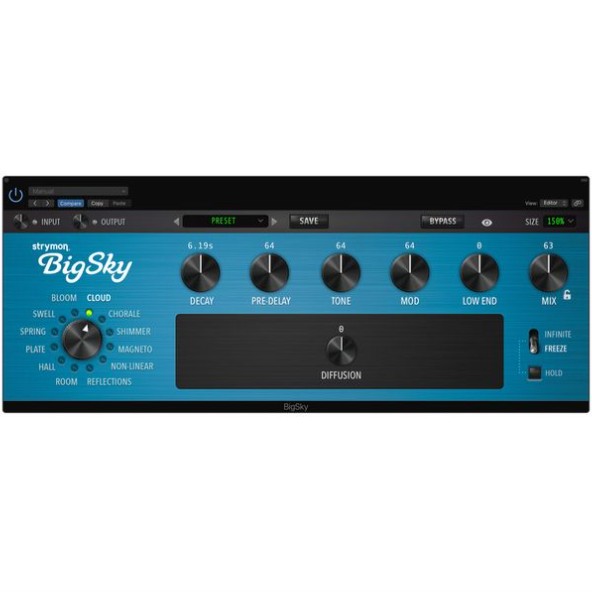
12 different reverb algorithms to choose from.
Variable and high-quality reverb effect with a wide tonal bandwidth from short, accentuated plate reverb for vocals to extremely wide, almost infinite decays.
Numerous new and innovative reverb parameters with pitch shifting, filters, tunable room ambience and much more.
Simple modulation assignments.
Hold button enables infinite sustain or freeze effects for sound experiments.
Scalable user interface with four different sizes to choose from.
4. Universal Audio Lexicon 224
Careful emulation of the legendary 1978 Lexicon 224 digital reverb, with its eight classic reverb programs and complementary chorus.
Uses the same algorithms and source code of the Lexicon hardware for the typical 1980s sound.
Exact replica of the original circuit with its sound-defining 12-bit AD/DA converters and input transformers.
Original typical user interface supplemented with hidden contemporary functions and advanced settings such as input and output levels, pitch shift, bug fix mode, etc.
5. Eventide Blackhole
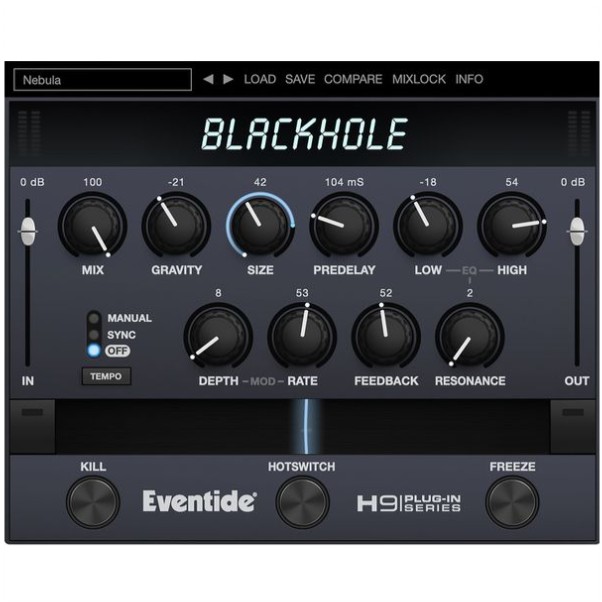
Algorithm from the DSP4000 and H8000 hardware units.
Especially suitable for producing guitar, pads, extreme spatial effects and drones.
Unique Gravity parameter with direction reversal in the time course of the reverb tail.
Synchronisable pre-delay with times of up to 2000 ms.
Freeze function for endless reverb.
Modulation parameter.
Feedback function and adjustable resonance.
Virtual Ribbon Macro controller for simultaneously assignable parameters.
6. Audio Ease Altiverb 8 Convolution
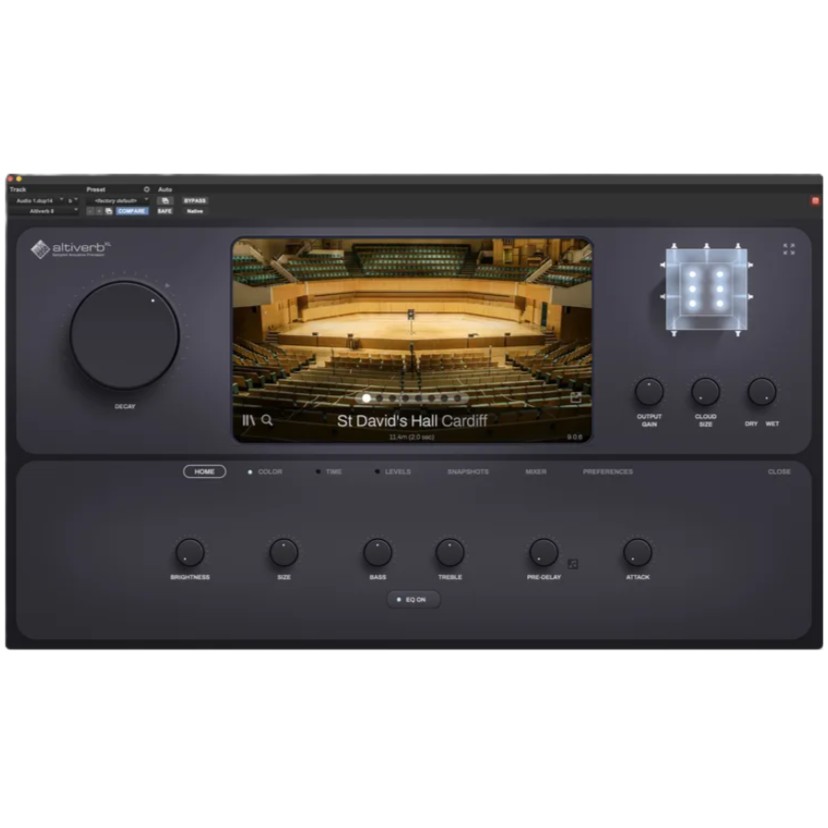
Expansive IR library with concert halls, orchestral studios, recording studios, common spaces, and classic hardware reverbs.
New IRs are added regularly for free.
Powerful sound-shaping controls, including reverb time, attack, brightness, pre-delay, EQ, damping, and more.
Access to special FX, including reverse, modulated, and gated reverbs.
Output level meters allow you to manipulate the level and delay time of each of your output channels.
IR tool for creating your own IRs.
7. Baby Audio Crystalline
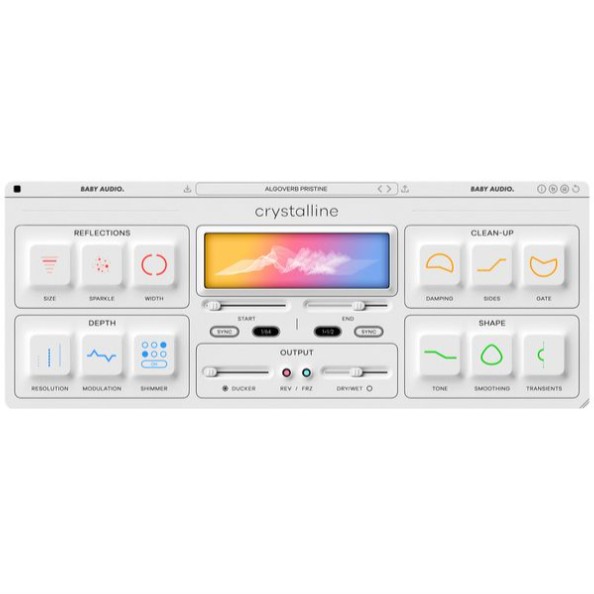
Algorithmic reverb software tailor-made for the DAW.
Wide range of creative features provide unencumbered control over reverberations.
Lets you sync reverb start and decay times to the bpm of your DAW.
Reflections: affects room size, brightness, stereo image width.
Clean-up: removes unwanted frequencies, introduces a high-pass filter, and engages a gated reverb sound.
Depth: toggles between "basic" and "complex" algorithms, dials in pitch variations, and slows high frequencies for an "angelic" effect.
Shape: shifts between bright and dark EQ settings, applies EQ curves to problem areas, and shifts reverb emphasis from attack to sustain.
8. Solid State Logic FlexVerb
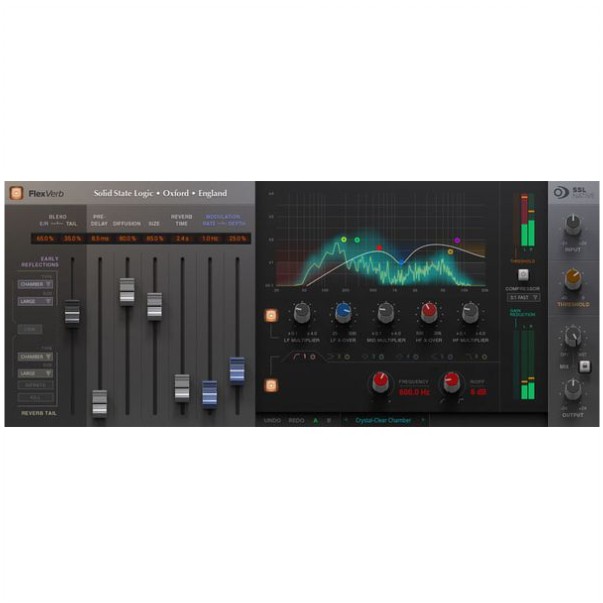
4 algorithmic reverb types: room, hall, plate, and chamber
Independently selectable early and late reflection types.
6-band SSL EQ for shaping the reverb’s frequency response.
Output compressor helps the reverb sit in the mix.
Lockable wet/dry mix control for matched preset comparisons.
Infinite reverb switch and reverb tail kill switch for dramatic FX.
9. Sonnox Oxford Native
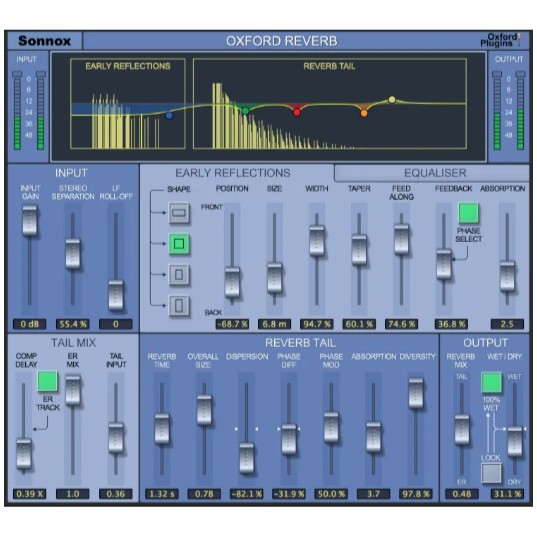
Loaded with over 100 presets divided into sub-categorized folders.
Realtime continuous control of virtually all parameters.
Dual independent paths provide control over both early reflections and reverb tails.
Input highpass filter and fully controllable 5-band parametric EQ onboard.
10. Soundtoys SuperPlate
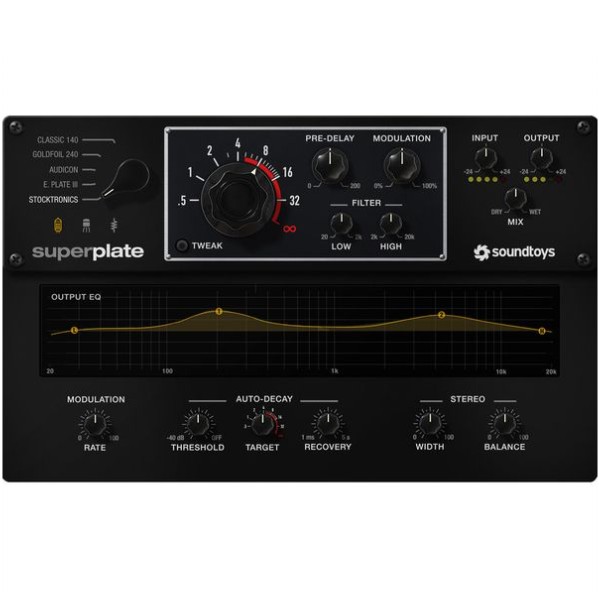
Careful emulations of five different electromechanical reverbs.
Based on the EMT 140, EMT 240, Audicon, EcoPlate III and Stocktronics RX4000 plate reverbs.
Switchable sound characteristics Tube (EMT V54), Solid-State (EMT 162) and Clean.
Standard parameters like reverb time, predelay, modulation and filter.
Advanced contemporary features such as endless reverb, modulation speed, full-featured EQ, stereo width and balance, and ducking function to automatically adjust reverb time and avoid overlapping and masking effects.
11. Zynaptiq Adaptiverb
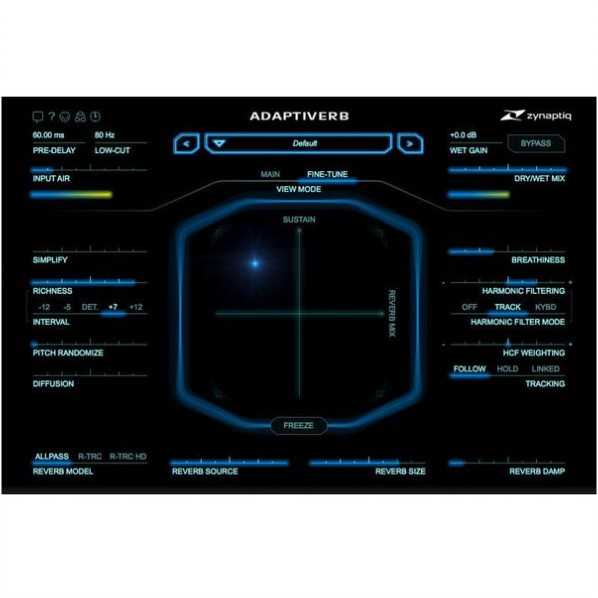
Innovative reverb processor based on resynthesis.
Eliminates unwanted components in the input signal and creates a clean reverb using ‘Bionic Sustain Resynthesis’.
Inharmonic effect components are removed with Harmonic Contour Filter (HCF).
Variable settings for HCF allow for versatile configurations.
Freeze function enables endless reverbs, drones or pad-like sounds.
Richness parameter adds unison, fifth or octave harmonics to the reverb.
Over 400 presets.
12. FabFilter Pro-R2
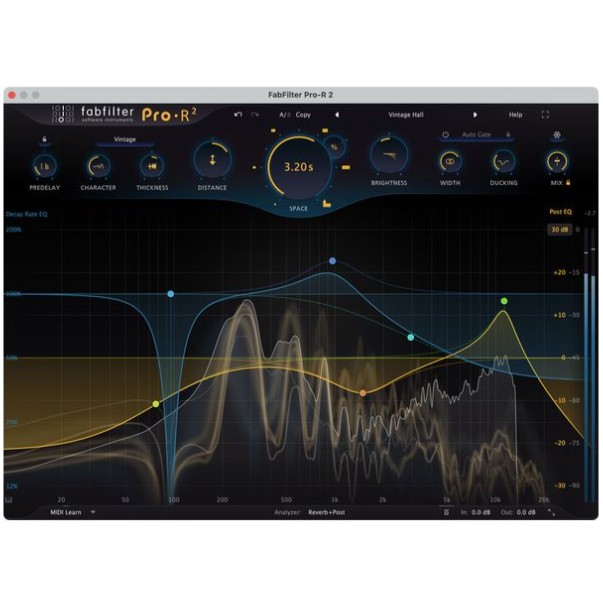
Algorithmic reverb with room simulations ranging from small ambience effects to cathedrals.
Clear interface with interactive reverb display, decay rate EQ and post-EQ display.
Three different algorithms: modern, vintage and plate.
Real-time spectrum analyser that also displays the decay time in relation to frequency.
Impulse Response Import: Impulse responses are converted by R2 into corresponding settings.
13. Overloud Breverb 2
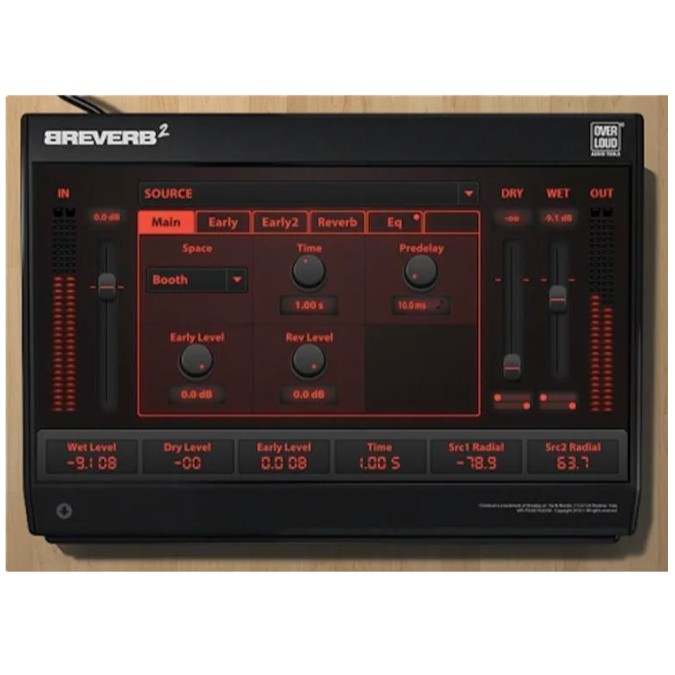
7 reverb algorithms: Hall, Room, Plate, Inverse, Small/Large Spaces, and Sources.
Full EQ section to tailor Breverb 2's frequency response.
Motion controls add liveliness and musicality.
Real-time MIDI control of all parameters through the six faders.
14. Overloud REmatrix
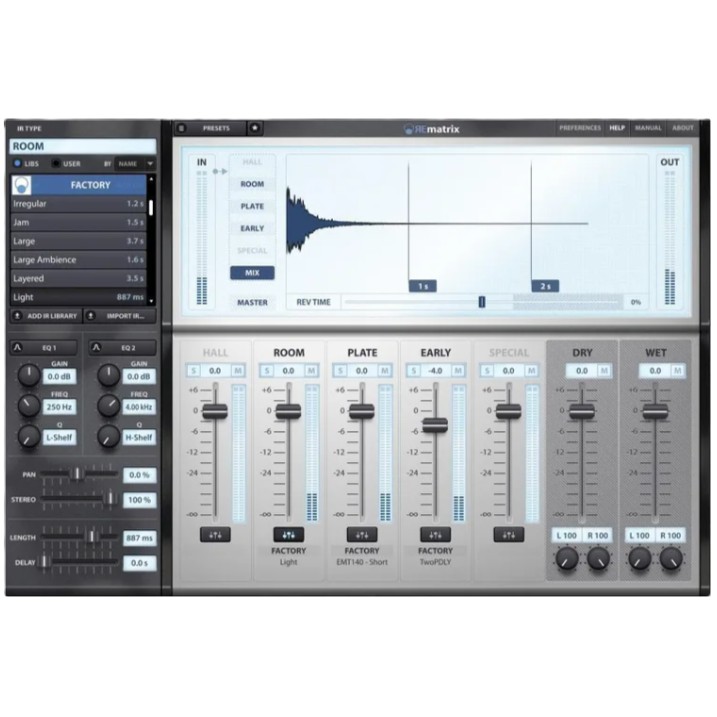
Convolution reverb plug-in with 5 individual convolvers.
Blend 5 IRs together to craft ambient textures.
Comprehensive effects chain with algorithmic reverb, delay, modulation, drive, compression, and EQ.
330 impulse responses and 670 presets categorized by instrument, genre, and application.
EQ, Pan, Stereo, Length, and Delay controls for each convolver.
15. Pulsar Audio Primavera
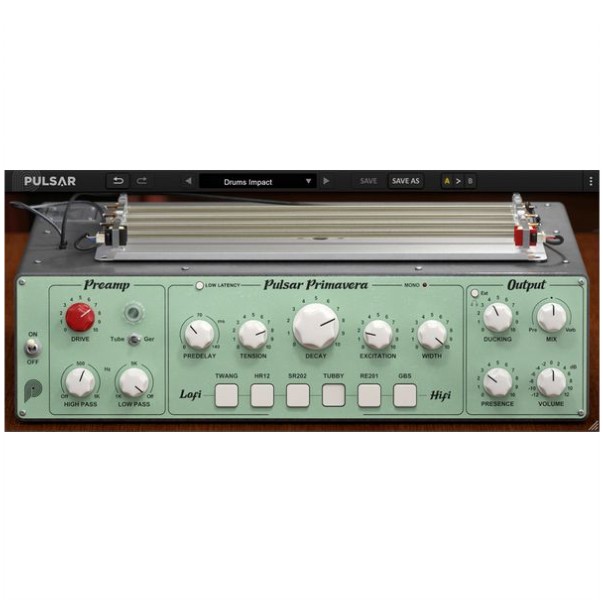
6 vintage spring reverbs with additional functions such as drive, filter, ducking and more.
Adjustable times for pre-delay and decay.
Transient-dependent and manual spring impact as well as adjustable spring tension and stereo width.
Ducking effect with external sidechain.
Drive section in the input with tube or germanium transistor circuit.
Integrated low-pass and high-pass filters with 12 dB / octave slope.
16. The Hit Factory Plugins HitVerb
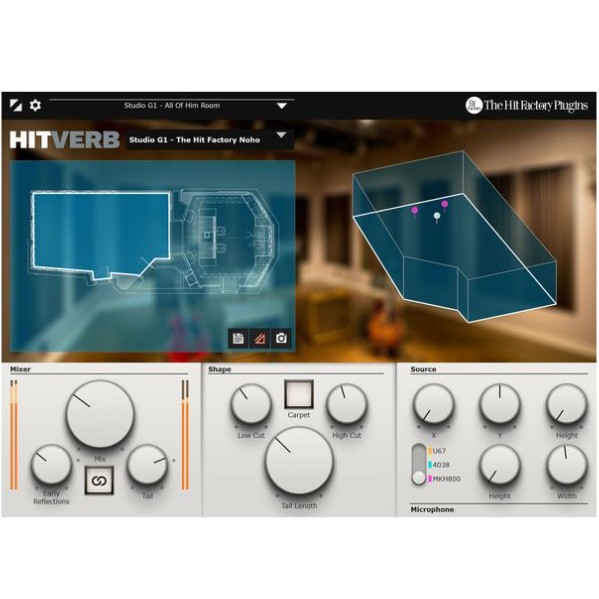
17. u-he Twangström
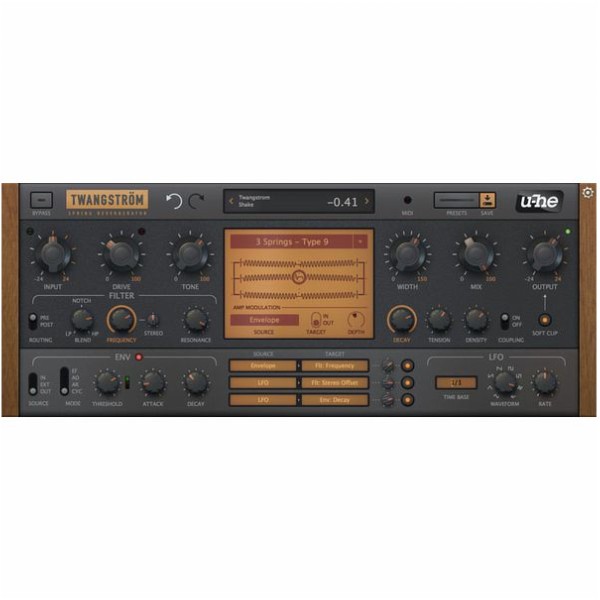
Detailed simulation of three popular reverb tanks.
"Drive" and "Tone" levels as well as variable filter unit (pre/post switchable) for flexible sound shaping options.
Modulation of up to 3 parameters via an envelope with 4 operating modes and an LFO with 8 vibration modes.
Simple MIDI control.
Controller assignment editable.
18. UVI Sparkverb
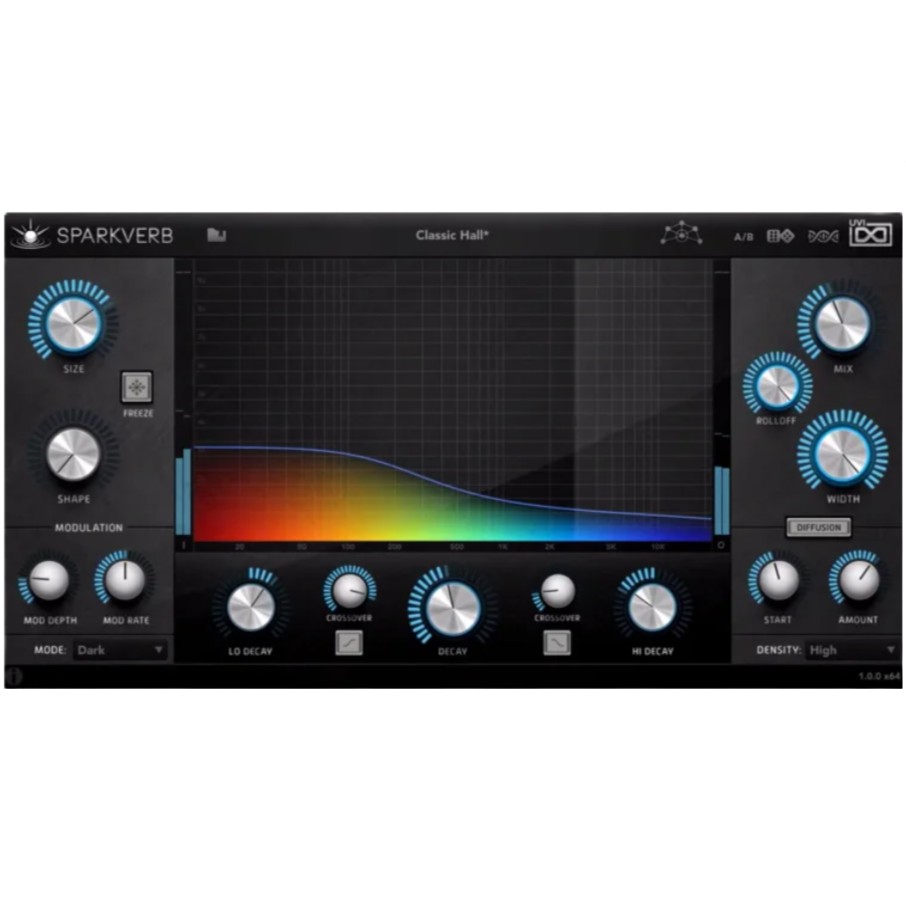
Simple single-window layout makes it easy to dial in parameters.
Freeze control lets you trigger infinite reverb decay.
Onboard modulation lets you add shimmer and shine to your sound.
Randomize and Mutate functions let you automatically vary your effect.
Preset Voyager allows you to morph between two or more presets.
19. Wave Arts MasterVerb
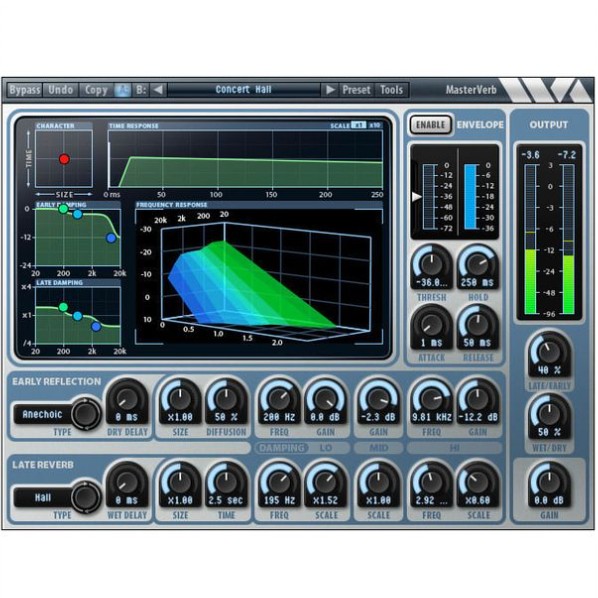
Two different algorithms: hall and plate, with independent control over parameters.
Early reflection section allows for various early reflection patterns, with adjustable size.
Interface allows you to quickly visualize the changes you're making.
3-D frequency response plot shows the reverb decay as a function of frequency.
Two onboard three-band EQs.
Early EQ shapes the overall tonality of the reverb response.
Late EQ shapes the frequency dependent decay.
20. Apogee Clearmountain's Spaces
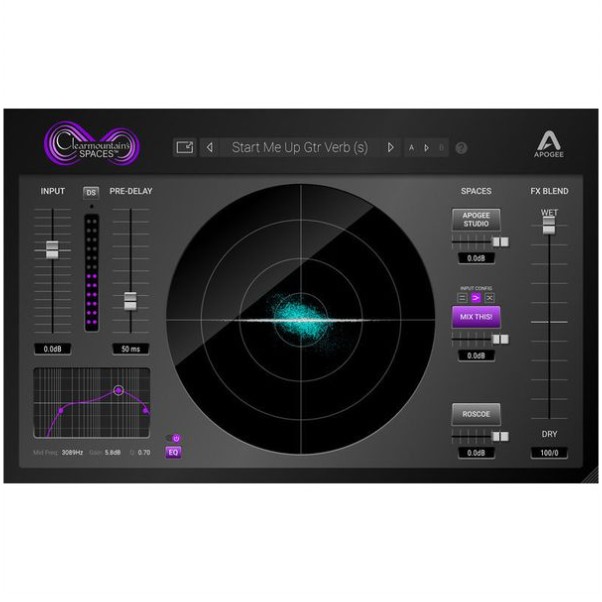
21. Avid ReVibe II Room Modeling
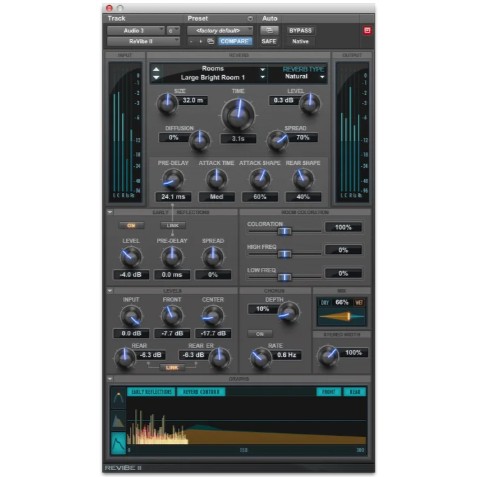
Multimodal reverb plug-in offers malleable and multidimensional room-modeling FX and more.
9 onboard reverb algorithms support myriad space-shaping capabilities, adding spring- and plate-style reverbs to your palette.
200 built-in reflection models ensure unrivaled precision and pliability in sculpting your space.
5.1 multichannel support includes simultaneous mono and stereo instances of each control.
22. Brainworx bx_rooMS
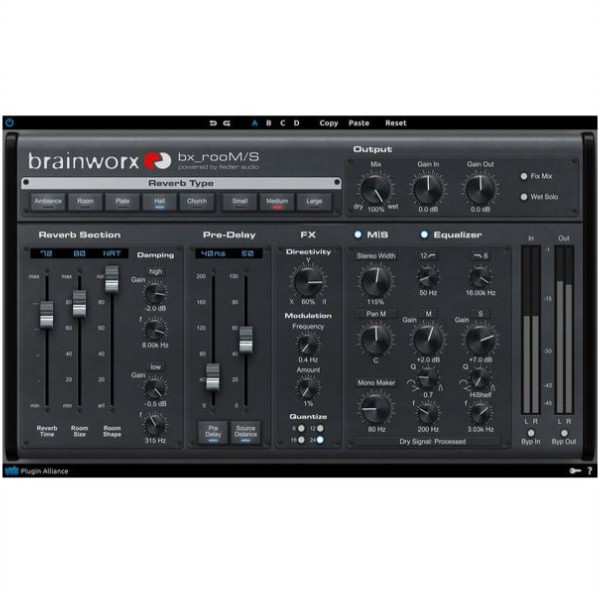
Algorithmic reverberation based on TrueSpace technology.
Offers a continuous selection of rooms with a constantly available full range of room sizes.
Allows an almost unlimited number of possible room shapes and sizes with just a few simple parameters.
Quick-select buttons can be used to make settings for five different rooms, each with three different sizes as a starting point for your own settings.
Mono-Maker creates a mono signal in the bass range below the adjustable cut-off frequency.
Fully parametric two-band EQ for mid and/or side signal.
23. Cherry Audio Galactic
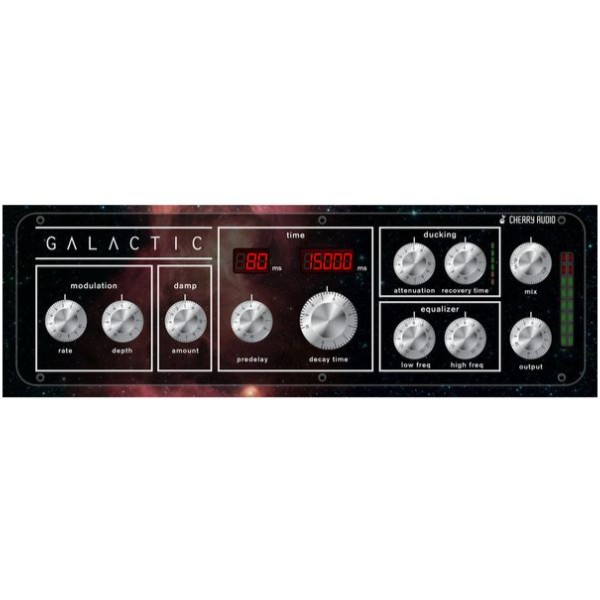
Algorithmic reverberation, sonically oriented to various classics.
Especially suitable for spherical guitars and pads, extreme space effects and drones.
Up to 35 seconds reverberation time.
Adjustable modulation from 0.1 Hz to 5 kHz.
Adjustable damping of the reverb tail.
Up to 500 ms pre-delay.
Integrated ducking function with adjustable damping and reset time.
Equaliser with HF and LF control.
Preset browser with over 50 presets in different categories, favorites function and user presets.
24. D16 Group Spacerek
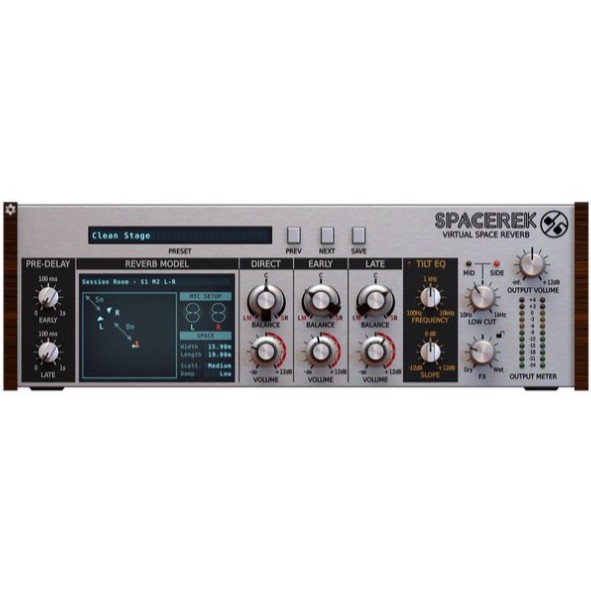
Hybrid room reverb algorithm combines Virtual Space Reverb for the initial reflections and Dynamic Delay Network for the reverb tail.
114 reverb variants with many different rooms, each with multiple speaker and microphone setups.
Mixer for direct signal, initial reflections and reverb tail
Tilt-EQ.
Low-cut filter, can be used independently for M/S channels.
25. DDMF Envelope True Stereo
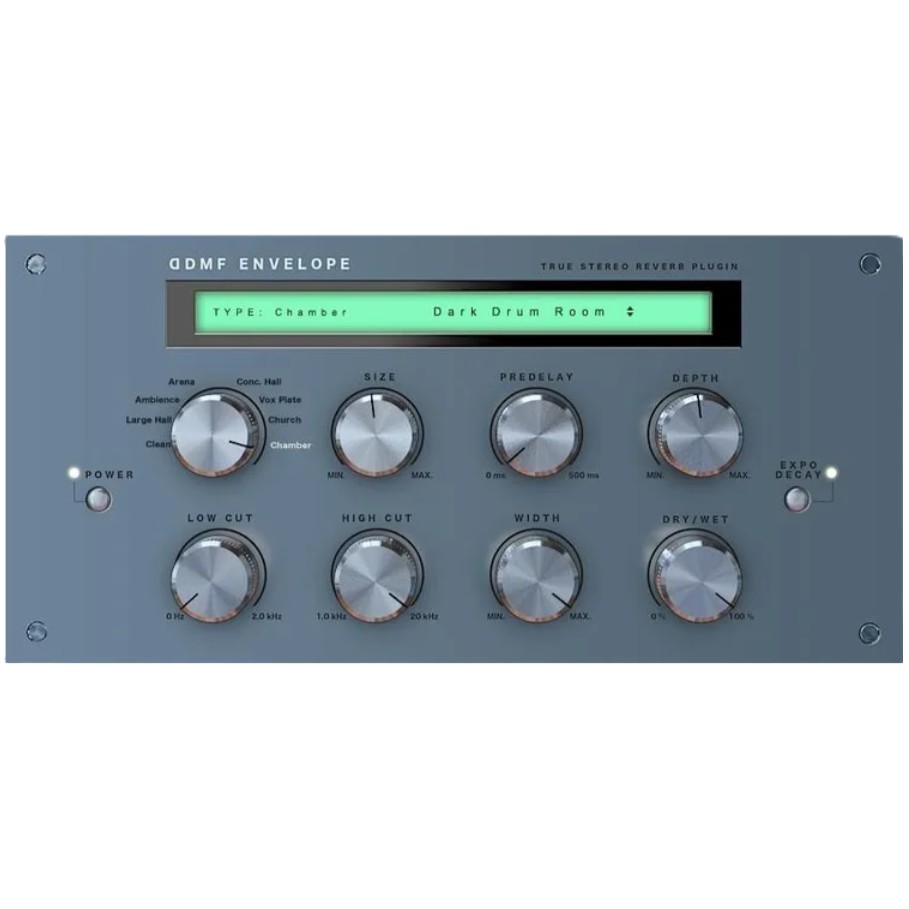
8 distinct true-stereo environments including: Chamber, Church, Vox Plate, Concert Hall, Arena, Ambience, Large Hall, Clean.
Depth, Size, and Pre-delay settings.
Low and high cut controls.
Exponential decay setting.
Stereo width control allows both full stereo and full mono operation.
30 studio-quality presets from DDMF.
26. EastWest Spaces II
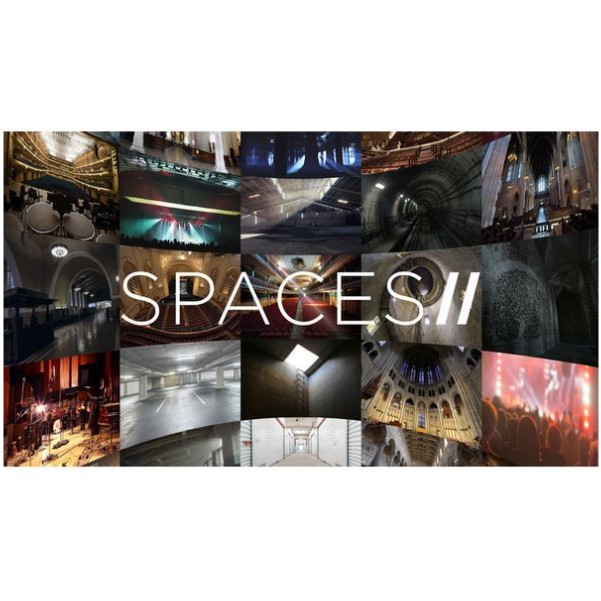
True stereo and surround convolution reverb with extensive library of impulse responses, such as concert reverbs, churches, cathedrals, recording studios, tunnels, swimming pools, reverb plates, reverberation units etc.
Clearly structured user interface with views of the individual rooms.
Decay and filter adjustable.
27. Eventide ShimmerVerb
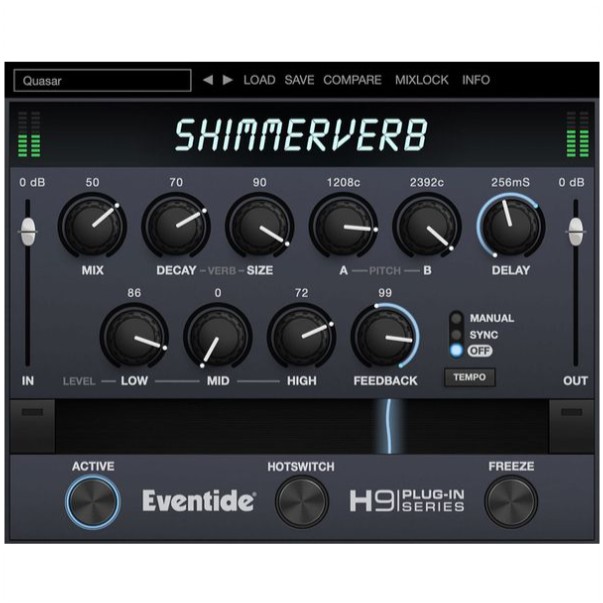
Reverb effect with pitch shifter parallel to the reverb tail, especially suitable for spherical and shimmering guitar and synth sounds, vocals but also drums.
+/-2 Octaves pitch change.
Delay up to one second to delay the pitch effect.
Feedback with adjustable low, middle and high frequencies.
Virtual ribbon macro-controller for simultaneous changes of commonly assigned parameters.
Hotswitch button allows switching between two parameter sets in the same preset.
28. Eventide SP2016
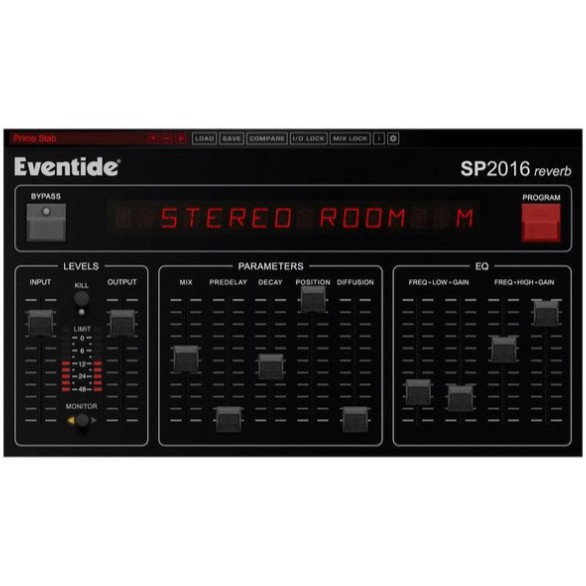
Simulation of the legendary SP-2016 hardware
Characteristic and dense reverberation.
Known from countless top production.
6 Specific reverb sounds: Room, Stereo Room and Hi-Density Plate algorithms - each in "vintage" and "modern" execution.
Contains a large selection of presets by renowned artists and producers.
29. Eventide Tverb
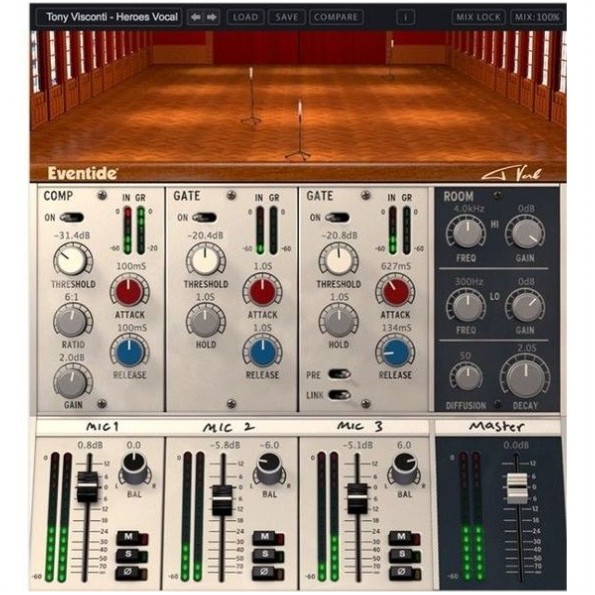
Emulation of Toni Visconti's microphone technique during the recording of David Bowie's "Heroes" at Hansa Studios Berlin.
A direct and two mobile room microphones for variable surround sound.
Microphone 1 with variable directional characteristics
Integrated compressor on mic 1.
Linkable gates in the microphone channels 2 and 3
Adjustable room parameters.
30. Eventide UltraReverb
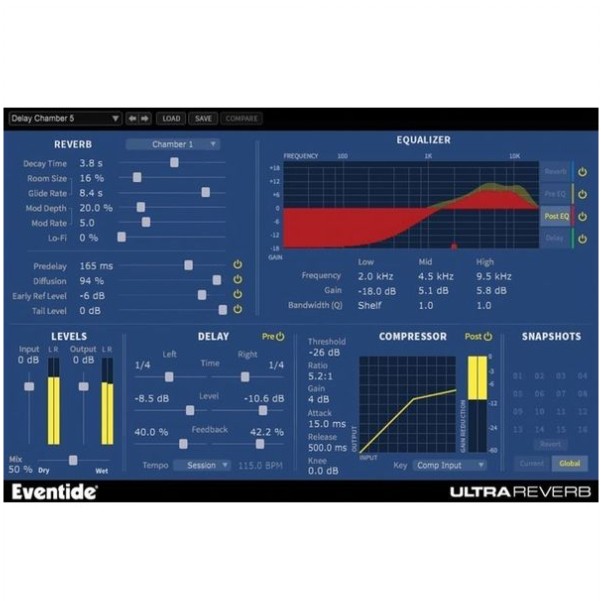
31. Flux Ircam Verb v3
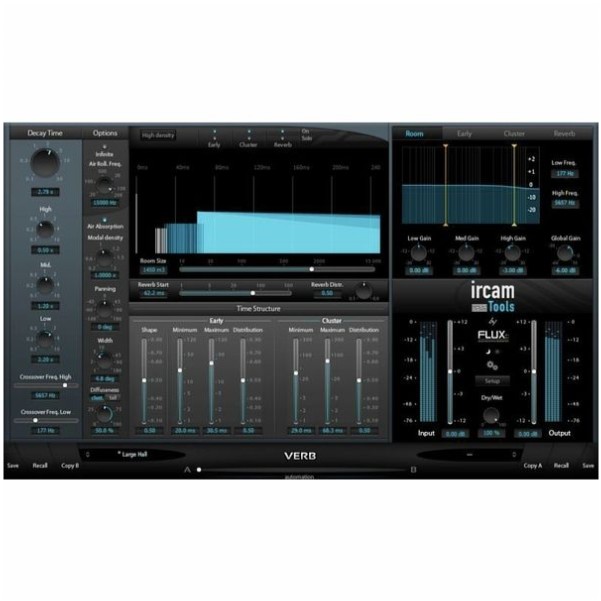
32. HOFA System AlgoVerb
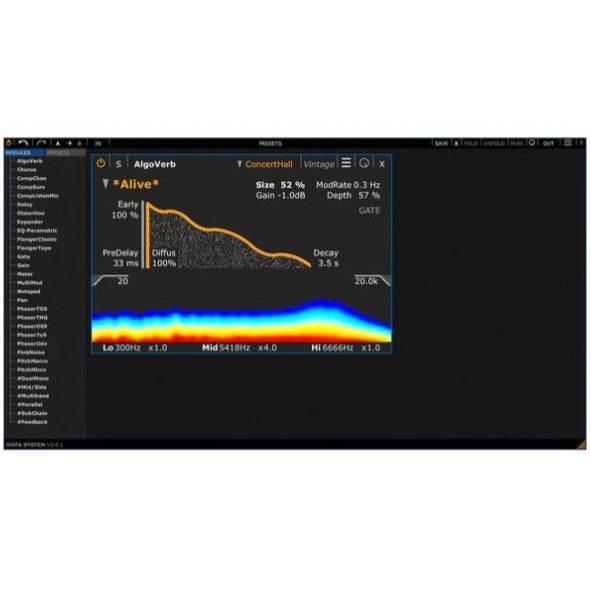
33. IK Multimedia CSR Classik Suite
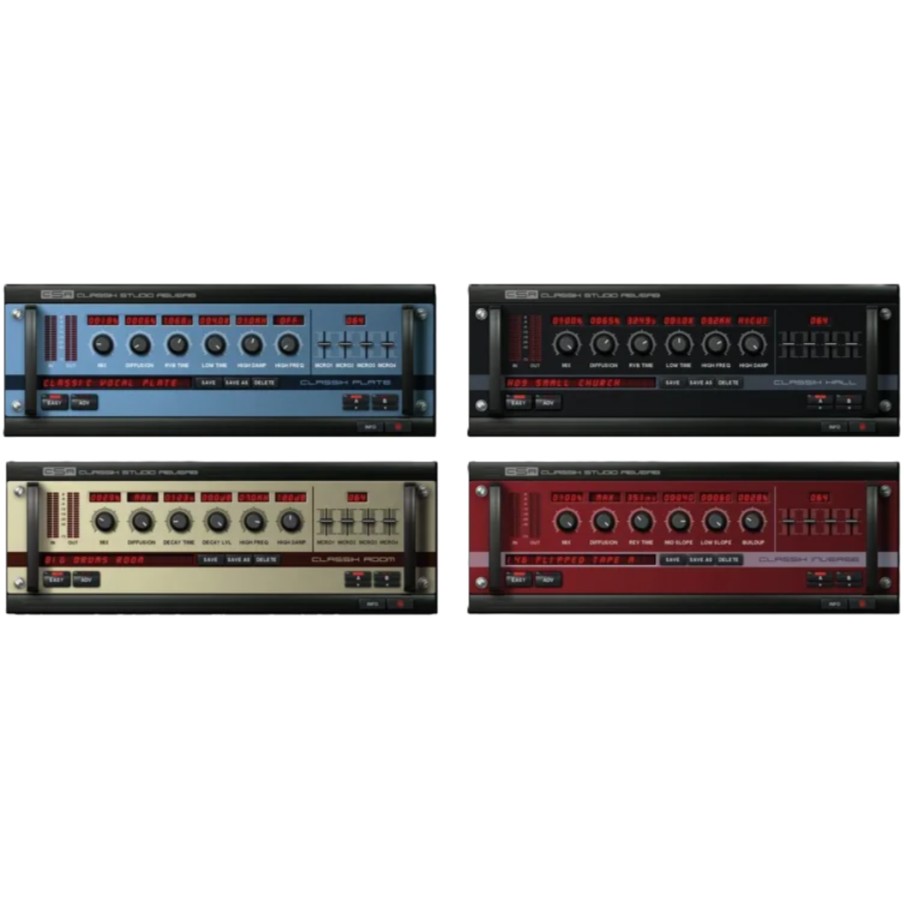
Suite of 4 separate reverb units: Plate, Room, Hall, and Inverse.
2 operational modes: Easy and Advanced.
6 easy to use controls in Easy Mode.
More than 100 Parameters in Advanced Mode.
Highly customizable 8x8 Modulation Matrix per unit.
4 assignable Macros per unit.
Full automation through host sequencer.
34. IK Multimedia Sunset Sound Studio
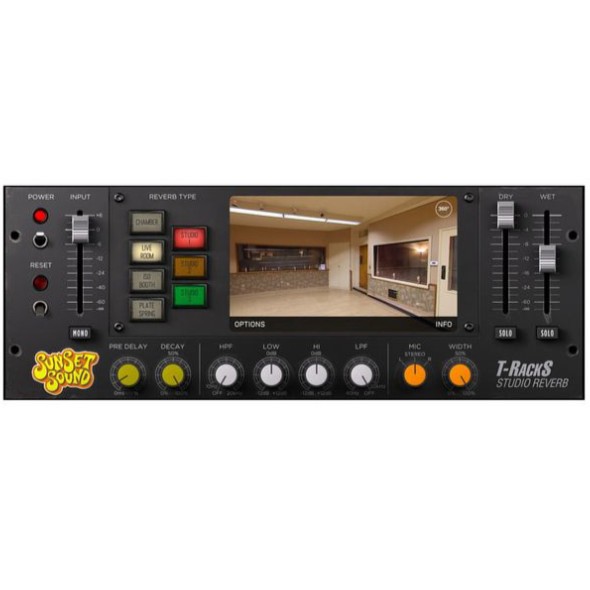
Effect module for the IK Multimedia T-RackS CS application and DAW plug-in.
Recreation of the acoustic situation of the Sunset Sound studio based on Volumetric Response Modelling.
Contains all recording rooms, studio rooms and 3 echo chambers.
Offers two reverb plates and a spring reverb.
Variable room acoustics and different microphone positions.
Pre-delay and decay time control, EQ and mic options.
35. iZotope Aurora
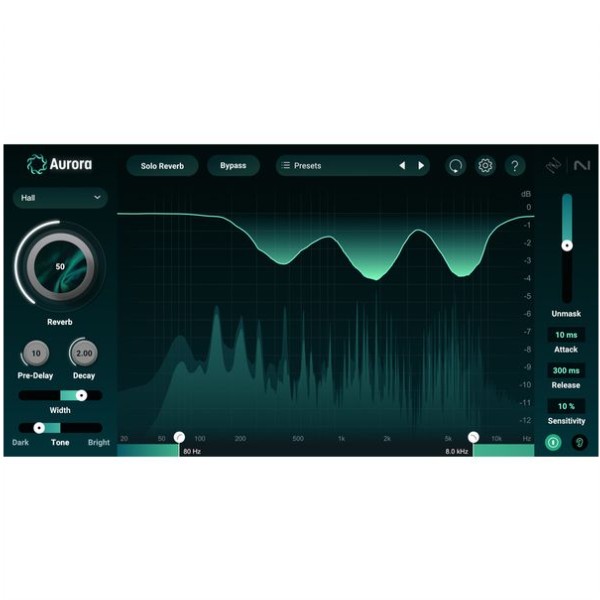
Reverb with spectral unmasking.
Six reverb types: Hall, Room, Chamber, Plate, Ambience and Cathedral.
Customisable, adaptive unmasking that reacts to the audio signal in real time.
Reverb controls: Pre-Delay, Decay, Width, Tone and Mix.
Unmasking controls: Attack, Release, Sensitivity and Frequency Bandwidth.
36. iZotope Equinox
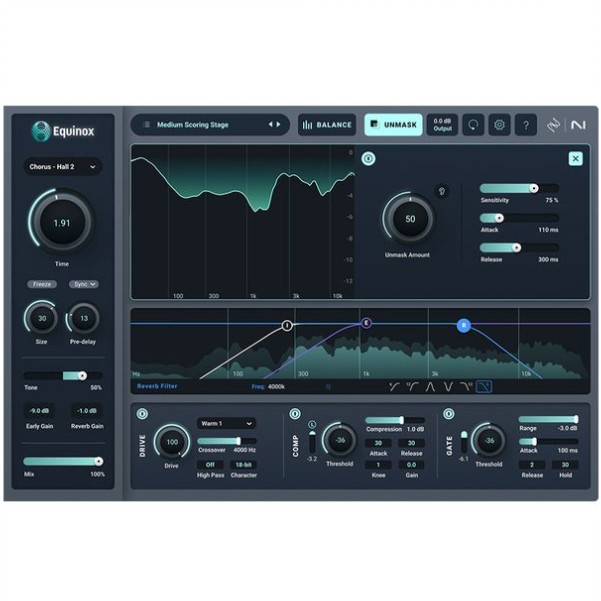
Surround and immersive reverb for post and music production.
Combines Exponential Audio's Stratus and Symphony engines in one plugin.
Advanced control options for shaping the tonality and behaviour of the reverb.
Global sound control with Tilt EQ for quick overall adjustments.
Dedicated reverb EQ for targeted sound shaping.
Creative features such as reverb freeze, chorus, gate and more.
Includes over 1250 presets.
37. iZotope Neoverb
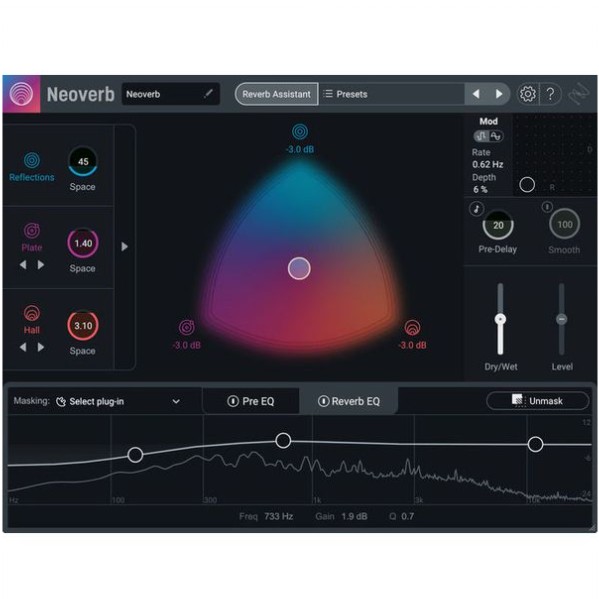
Reverb based on Exponential Audio's well-known reverb algorithms.
Blend Pad allows mixing of three different reverb algorithms in a simple and clear way.
EQ section with Unmask function, AutoCut and Masking Meter.
Advanced control parameters for detailed manual settings.
Over 100 presets in categories.
38. Klevgrand Kleverb
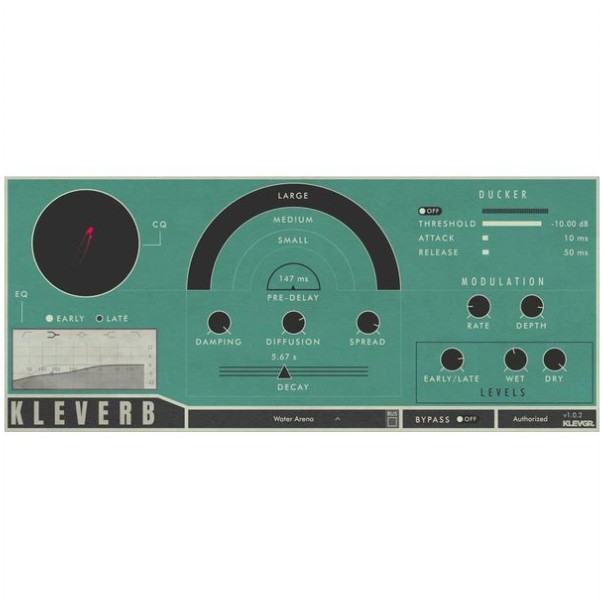
39. Klevgrand Rum
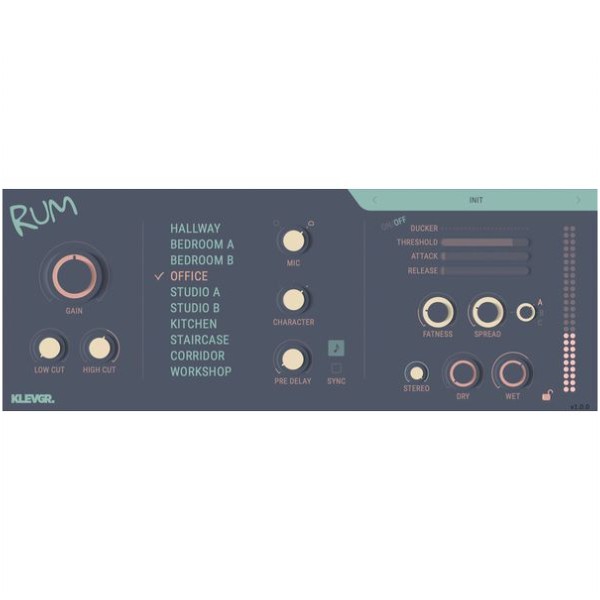
40. McDSP Revolver Native
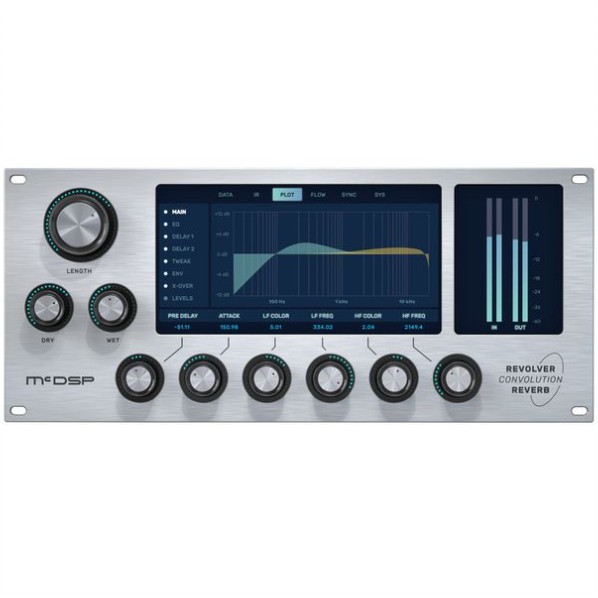
41. Nomad Factory 80s Spaces
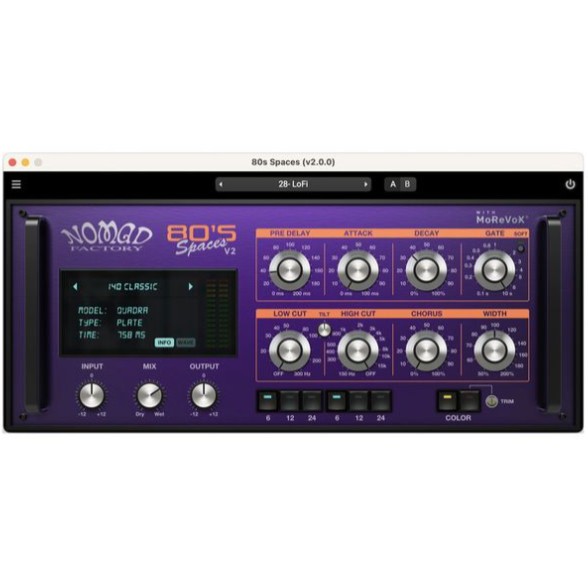
Convolution reverb based on impulse responses of legendary reverberators of the 1980s.
Provides 249 impulse responses from 12 different reverbs.
Adjustable reverb parameters pre-delay, attack, decay and gate.
Additional low-pass, high-pass and tilt filters.
Additional chorus effect.
Over 500 presets.
42. Nugen Audio Paragon
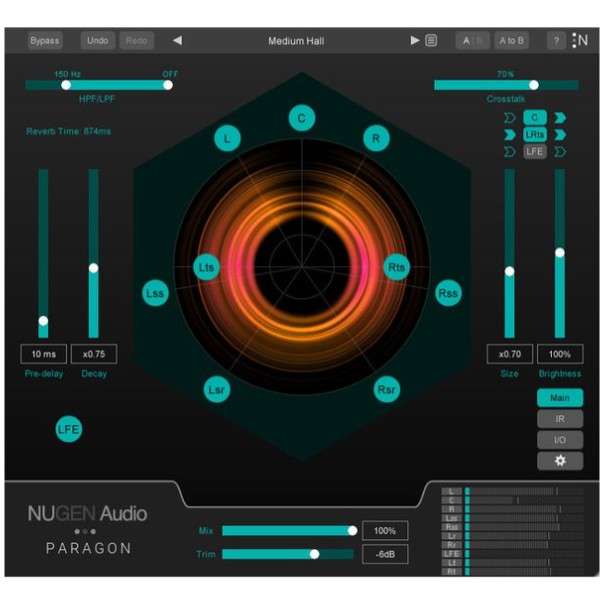
Flexible and natural convolution reverb for post-production and surround applications.
Compatible with Dolby Atmos and other surround formats
Re-synthesis allows significant modifications of fundamental reverberation parameters such as reverb decay, room size, etc., without unwanted artefacts.
Distance parameter to control the perceived distance to the sound source.
Optimised IR library that gets by with a manageable amount of impulse responses.
Hi- and lowpass filter per channel.
Switchable LFE channel.
Stereo width control.
43. PSP Audioware 2445
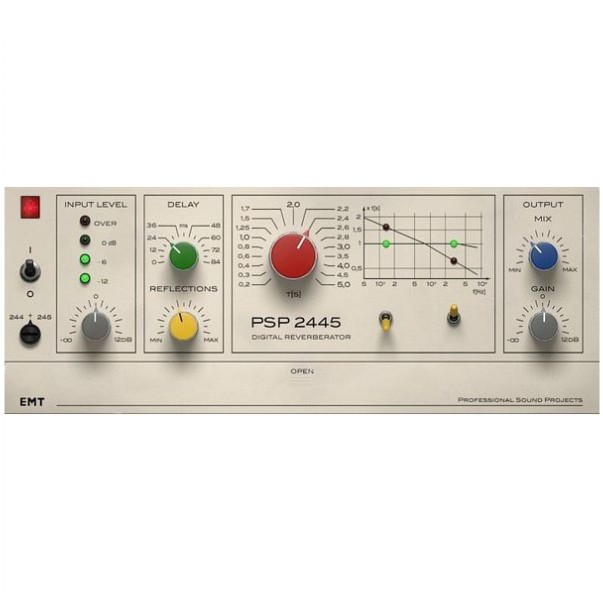
44. PSP Audioware SpringBox
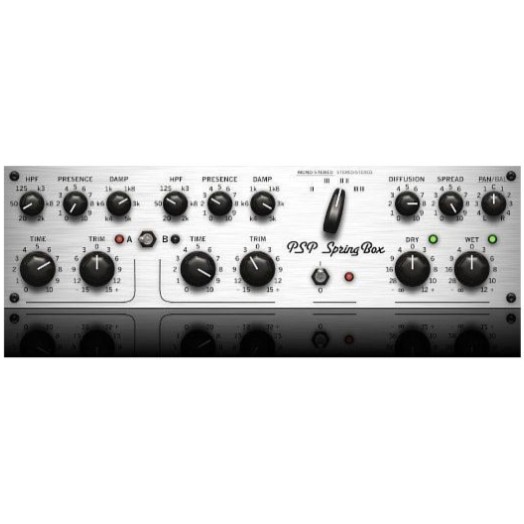
45. Slate Digital Verbsuite Classics
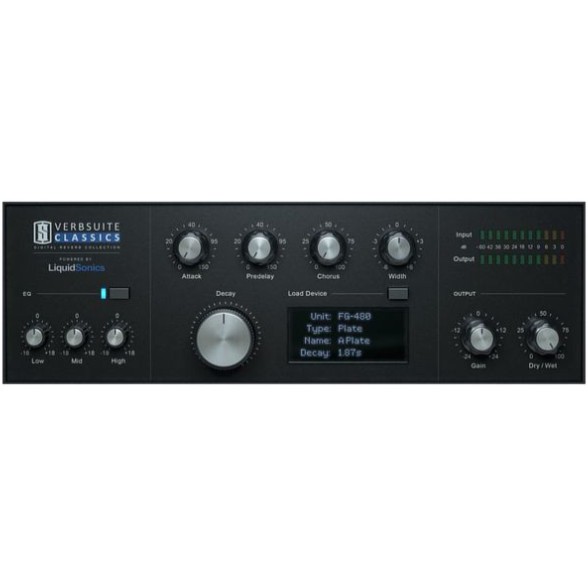
Convolution reverb based on Fusion IR technology, which overcomes the disadvantage of static impulse responses.
Includes impulse responses from eight well-known reverb classics.
Highly tweakable with Decay, Attack, Pre-delay, Width, and Chorus controls.
3-band EQ shapes the color of your reverb.
Dry/Wet control for adjusting your mix output.
46. Strymon Cloudburst
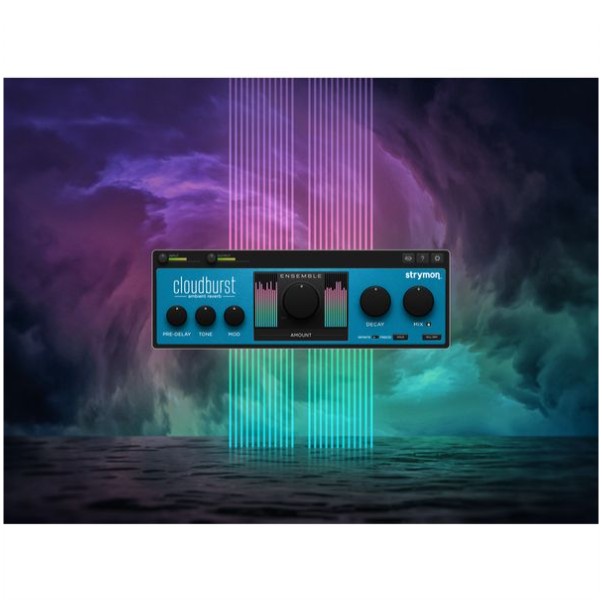
Ambient reverb effect with optional ensemble sound layering for dense, atmospheric sound spaces.
Plug-in version of the Cloudburst Reverb pedal from Strymon.
From natural-sounding small rooms to epic, expansive soundscapes.
The ensemble effect analyses the input signal and uses it to create a harmonically rich, string-like pad that is mixed into the reverb.
Reverb parameters: Pre-Delay, Tone, Mod, Ensemble Amount, Decay and Mix.
Infinite & Freeze Hold and Kill Dry function.
47. tc electronic TC8210
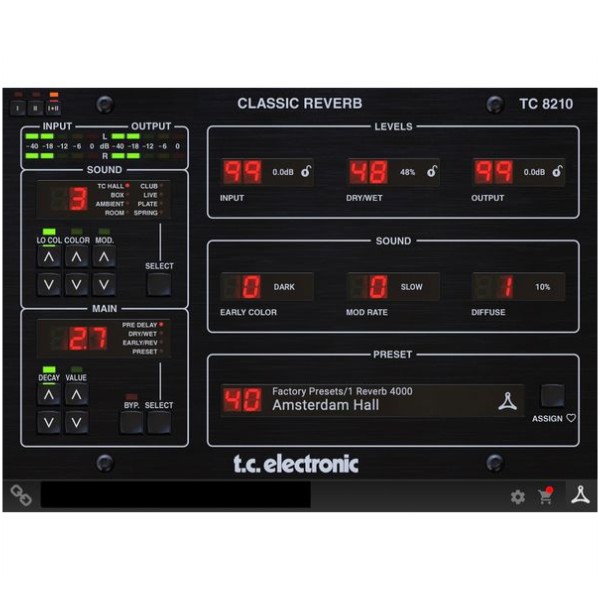
Careful emulation of the well-known TC8210 reverb unit.
Clear reverb effect that preserves the natural characteristics of the source sound.
Offers the classic and high-quality reverb algorithms TC Hall, Ambient, Hall, Plate, Spring, Live, Club and Box.
Detailed editing options for precise adjustment of the effect to your own sound ideas.
48. Waves CLA Epic
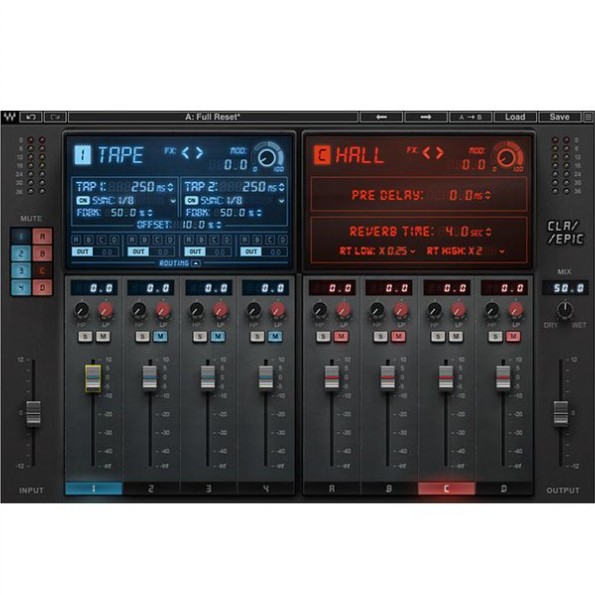
Chris Lord-Alge's complete suite of reverb and delay effects.
4 delay modules: Slap, Throw, Tape and Crowd.
4 reverb modules: Plate, Room, Hall and Space.
Layer and blend functions, as well as modulation and routing options for all effects.
With 50 presets by Chris Lord-Alge.
More than 300 additional presets by Greg Wells and Michael Brauer, among others.
49. Waves H-Reverb Hybrid
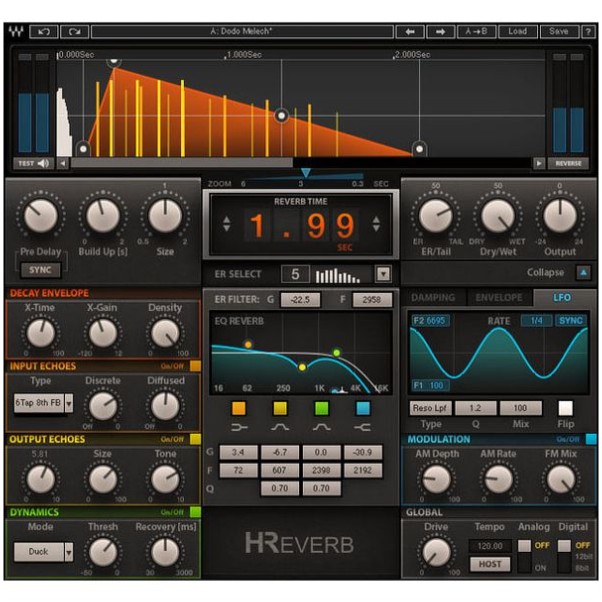
50. Waves IR1
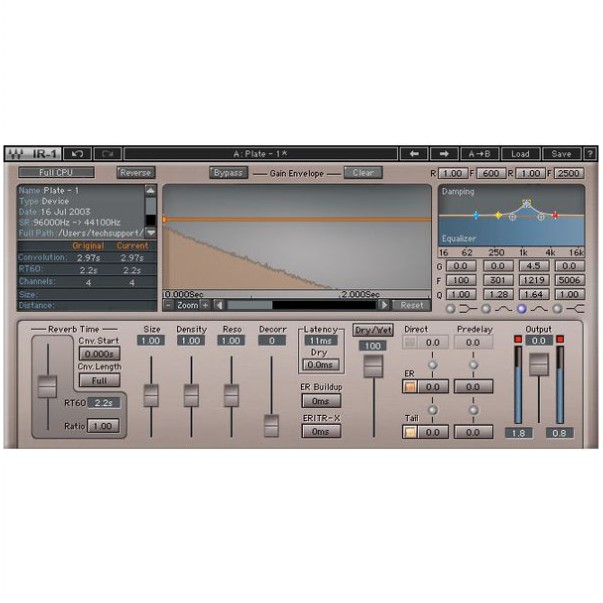
51. Waves Manny Marroquin
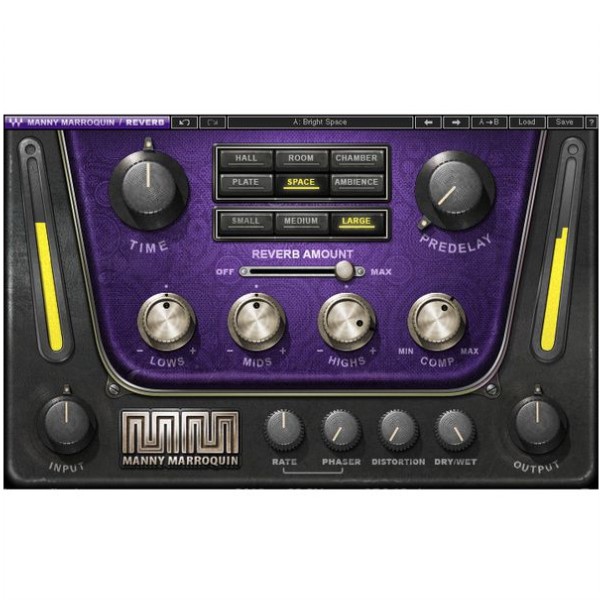
The buttons on this page are affiliate links, so we may earn a commission at no extra cost to you.
Suggest a product
If you believe a suitable product is missing from the list, kindly email us at suggestion@geardecider.com with the name of the list and the suggested product. If the product aligns with the list’s criteria, we will add it promptly.
Reverb is the echo-like sound that happens when audio bounces off walls and fades away. Clap your hands in a church or a gym and you’ll hear it, reflections building up and dying out. In music production, reverb recreates that feeling of space so a track doesn’t sound flat.
What reverb plugins do.
Reverb plugins are software tools that simulate different acoustic spaces inside your DAW. Instead of recording in a real hall or cave, you load a plugin to place a vocal, drum, or instrument in a chosen environment. Some plugins aim for realistic rooms; others create creative, unreal atmospheres.
Main types of reverb.
Algorithmic Reverb: Uses math to simulate reflections; flexible and light on CPU.
Convolution Reverb: Uses recorded impulse responses of actual spaces for realistic results.
Hybrid Reverb: Mixes algorithmic and convolution approaches for realism with tweakability.
Common uses.
Vocals: Small amounts make a voice sound natural; long tails add emotion or distance.
Drums: Short room or plate reverbs add punch and sense of space.
Guitars and Keys: Create ambience or push sounds back in the mix.
Sound Design: Build otherworldly spaces for film, games, or experimental music.
Practical tips for using reverb.
Pick the right type for the role: small rooms for intimacy, halls for cinematic depth.
Set pre-delay to separate the source from the reverb; short for blend, longer to keep clarity.
Adjust decay time to match the song: short for tight mixes, long for ambient textures.
Use sends instead of inserts so multiple tracks share the same reverb and save CPU.
EQ the reverb to remove low-mud and tame harsh highs.
Automate sends to change the sense of space between sections.
When to hold back.
Too much reverb blurs detail. Dry elements give focus and contrast. If you hear the reverb more than the instrument, dial it down.
Why reverb matters.
Reverb shapes mood as much as space. A dry signal feels personal and close; a lush reverb can make a part feel distant, dreamy, or epic. Used well, reverb ties a mix together and tells the listener how to feel.
Reverb plugins are simple but powerful: they create believable rooms or wild textures, help instruments sit together, and add emotional depth to your mixes.
